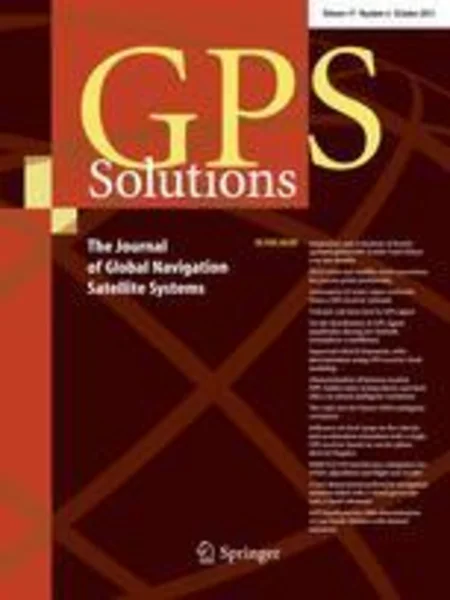-
assessment of troposphere mapping functions using three-dimensional ray-tracing
جزئیات بیشتر مقاله- تاریخ ارائه: 1392/07/24
- تاریخ انتشار در تی پی بین: 1392/07/24
- تعداد بازدید: 869
- تعداد پرسش و پاسخ ها: 0
- شماره تماس دبیرخانه رویداد: -
the troposphere delay is an important source of error for precise gnss positioning due to its high correlation with the station height parameter. it has been demonstrated that errors in mapping functions can cause sub-annual biases as well as affect the repeatability of gnss solutions, which is a particular concern for geophysical studies. three-dimensional ray-tracing through numerical weather models (nwm) is an excellent approach for capturing the directional and daily variation of the tropospheric delay. due to computational complexity, its use for positioning purposes is limited, but it is an excellent tool for evaluating current state-of-the-art mapping functions used for geodetic positioning. many mapping functions have been recommended in the past such as the niell mapping function (nmf), vienna mapping function 1 (vmf1), and the global mapping function (gmf), which have been adopted by most igs analysis centers. a new global pressure temperature model (gpt2) has also been developed, which has been shown to improve upon the original atmospheric model used for the gmf. although the mapping functions mentioned above use the same functional formulation, they vary in terms of their atmospheric source and calibration approach. a homogeneous data set of three-dimensional ray-traced delays is used to evaluate all components of the mapping functions, including their underlying functional formulation, calibration, and compression method. additionally, an alternative representation of the vmf1 is generated using the same atmospheric source as the truth data set to evaluate the differences in ray-tracing methods and their effect on the end mapping function. the results of this investigation continue to support the use of the vmf1 as the mapping function of choice when geodetic parameters are of interest. further support for the gpt2 and gmf as reliable back-ups when the vmf1 is not available was found due to their high consistency with the nwm-derived mapping function. additionally, a small latitude-dependent bias in station height was found in the current mapping functions. this bias was identified to be due to the assumption of a constant radius of the earth and was largest at the poles and at the equator. finally, an alternative version of the vmf1 is introduced, namely the unb-vmf1 which provides users with an independent nwm-derived mapping function to support geodetic positioning.
مقالات جدیدترین رویدادها
-
استفاده از تحلیل اهمیت-عملکرد در ارائه الگوی مدیریت خلاقیت سازمانی و ارائه راهکار جهت بهبود
-
بررسی تاثیر ارزش وجوه نقد مازاد بر ساختار سرمایه شرکت های پذیرفته شده در بورس اوراق بهادار تهران
-
بررسی تأثیر سطح افشای ریسک بر قرارداد بدهی شرکت های پذیرفته شده در بورس اوراق بهادار تهران
-
بررسی تأثیر رتبه بندی اعتباری مبتنی بر مدل امتیاز بازار نوظهور بر نقد شوندگی سهام با تأکید بر خصوصی سازی شرکت ها
-
تأثیر آمیخته بازاریابی پوشاک ایرانی بر تصویر ذهنی مشتری پوشاک ایرانی (هاکوپیان)
-
محاسبه هسته مقطع
-
تاثیر روش های مختلف خشک کردن بر میزان بتاگلوکان و دیگر خصوصیات کیفی قارچ دارویی آگاریکوس بلازئی
-
بررسی توزیع فضایی- زمانی شدت خشکسالی در استان سمنان
-
مردم سالاری از دیدگاه نهج البلاغه
-
ارتباط بین شاخص های آنتروپومتری (bf% و bmi) و بروز ناهنجاری های اسکلتی عضلانی بالاتنه در دانش آموزان پسر دبیرستانی شهرستان همدان
مقالات جدیدترین ژورنال ها
-
مدیریت و بررسی افسردگی دانش آموزان دختر مقطع متوسطه دوم در دروان کرونا در شهرستان دزفول
-
مدیریت و بررسی خرد سیاسی در اندیشه ی فردوسی در ادب ایران
-
واکاوی و مدیریت توصیفی قلمدان(جاکلیدی)ضریح در موزه آستان قدس رضوی
-
بررسی تاثیر خلاقیت، دانش و انگیزه کارکنان بر پیشنهادات نوآورانه کارکنان ( مورد مطالعه: هتل های 3 و 4 ستاره استان کرمان)
-
بررسی تاثیر کیفیت سیستم های اطلاعاتی بر تصمیم گیری موفق در شرکتهای تولیدی استان اصفهان (مورد مطالعه: مدیران شرکتهای تولیدی استان اصفهان)
-
بررسی تاثیر ویژگی های شغلی بر رفتار شهروندی سازمانی (مطالعه موردی: شهرداری منطقه 4 مشهد)
-
ارتباط بین رهبری تحول گرا و عملکرد شغلی مطالعه موردی (کارکنان بیمارستان کاشانی شهرکرد)
-
پوشاک زنان در پنج دوره تاریخی پس از ورود اسلام به ایران
-
برون سپاری ـ مزایا و ریسک ها
-
اشتباه در شخصیت در عقد نکاح و ضمانت اجرای آن




سوال خود را در مورد این مقاله مطرح نمایید :